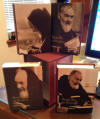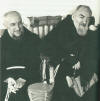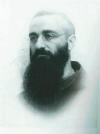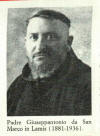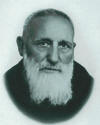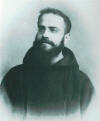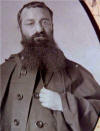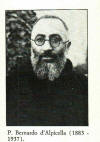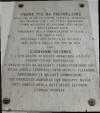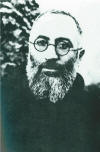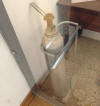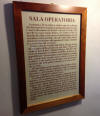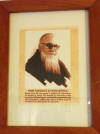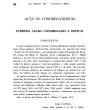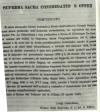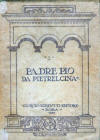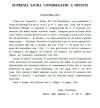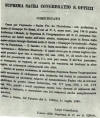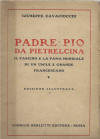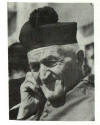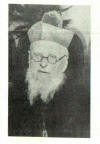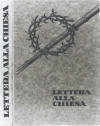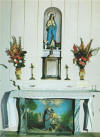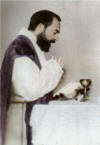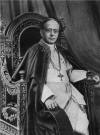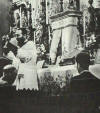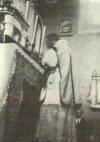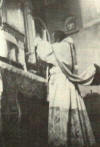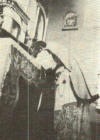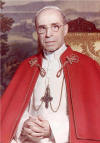7.
Inquisition by the Holy Office, and isolation
Summary: The crowds, resentment in the clergy, newspapers. Lemius, Rossi.
Disposition, demonstration, hernia operation, deliberation. Epistolary. Transfer
aborted,
“imprisonment”, restrictions.
(1919-39)
The crowds
By the summer of 1919 the scene was one of pandemonium. The little
church was invaded by peasants, artist, writers, politicians, lawyers,
doctors, journalists, curious, fanatics, thieves, pickpockets, sick
wanted to be cured, possessed wanting to be freed.[1]
Padre Pio's habit, with cuts at the bottom
The convent was not spared. People cut pieces from cassocks, chasubles,
albs, and anything that presumably had been used by Padre Pio, such as
straws from chairs were he had been seated. Whenever Padre Pio appeared
in public they cut pieces of his clothing.[2]
In April 1919 Padre Pio complained to Padre Benedetto that his breviary
had been stolen.[3]
[4]
People stayed around the convent for days, and since there were no
hotels or private homes outside the town a mile away, they slept under
the stars, ate what they could, and drunk well water.[5]
There was no sanitation and many were sick.[6]
A prayer card with a picture taken on June 24, 1919
A prayer card stating that the picture was taken on June 27, 1919, and calling Padre Pio "The Holy Priest".
The Capuchin friars deplored what was happening, including the publicity
by the press, forbidden by Canon Law.[7]
Resentment
In the town of San Giovanni Rotondo things had changed dramatically
since the news about Padre Pio spread. One of the changes was that many
faithful started deserting the local parish and went to the convent for
religious services. This emptied the churches in town and made some of the
local clergy resentful.
Don Giovanni Miscio, don Giuseppe Prencipe and don Domenico Palladino
accused the friars of
“putting Padre Pio on display for the purpose of making money”.
Mons. Gagliardi
The Bishop of Manfredonia, Mons. Pasquale Gagliardi, with jurisdiction
over San Giovanni Rotondo, got informed, noticed, and joined the action
against the convent.
They “bombarded the Vatican with complaints about Padre Pio.” Gagliardi
went to the Vatican deploring Padre Pio’s horrible manner of hearing
confessions” leaving the souls “in a state of agitation”. He insisted:
“Padre Pio is demon-possessed and the friars of San Giovanni Rotondo are
a band of thieves.” He added: “With my own eye I saw Padre Pio perfume
himself and put makeup on his face! All this I swear on my pectoral
cross.” He also state that Padre Pio habitually slept
in the friary’s guest room attended by young girls with whom he
took liberties. Gagliardi also charged that the friars were living in
“unspeakable luxury, and were raking in huge sums of money.[8]
Rumor of transfer
In September 1919 a rumor spread that Padre Pio was going to be
transferred. The citizen made massive public demonstrations and stayed
around to guard the monastery day and night.[9]
[10]
October 14, 1920
Since the day of the socialist victory, there was strong animosity between the two groups. On the afternoon of October 14, the inauguration of the new socialist major Luigi Tamburrano was planned, and clashes among the factions were anticipated.
The socialists reportedly wanted to substitute the “Tricolore” with the “Red Flag” on the balcony of city hall. In the square there were about 600 socialists, 100 of the other party, 50 Carabinieri, 80 Army soldiers. In the escalating tension, a civilian grabbed a rifle from a soldier, and shot the carabiniere Vito Imbriani.
A chaotic clash ensued with knives, sticks, farming tools, and firearms. The carabinieri and the soldiers fired on the crowd. Besides the carabiniere,
13 civilians died. There were also 30 people wounded.
Morcaldi: “Approach the leaders, calm them down. You have to pacify them.[11] [12]
Another rumor of transfer
On June 21, 1921 a visiting priest was suspected by the people as the
one assigned to prepare for the transfer of Padre Pio, and they stormed
the monastery.[13]
[14]
The Napoli newspaper "Il Mattino" reporting about Padre Pio
For several months the stigmatization of Padre Pio was known only to few
people.
Than he news spread, and pilgrims and curious arrived at the convent,
from Southern Italy, then from the whole Italy and from abroad.
[15]
On May 9, 1919 the “Il Giornale d’Italia” was the first newspaper to
report about Padre Pio.
On June 1, 1919 “Il Tempo” run a title “Il miracolo di un Santo”
describing he instantaneous healing of a soldier by Padre Pio. The
article had been written by Adelchi Fabbrocini. On June 3, 1919 the same
paper “Il Tempo” titles “I miracoli di Padre Pio a San Giovanni
Rotondo”, reports some prodigies attributed to the friar. The paper also
reports that “at times his body reaches temperatures of 50 C (F 122) as
it has been observed with bath thermometers).”[16]
On June 19, 1920 the “Daily Mail” reports “extraordinary events happening daily in San Giovanni Rotondo”, and describes how the wounds had been investigated by the doctors and prelates.“
On June 20 and 21, 1919, the journalist, Renato Trevisani, on the
Napoli’s newspaper “Il Mattino”, in full page describes that “Padre Pio,
‘The Saint’ of San Giovanni Rotondo, makes a miracle on the person of
the town’s chancellor.”[17]
[18]
[19]
On October 27, 1923
the Belgian newspaper “Le Soir” describes the wounds, the examinations,
the prodigies and the “very high fevers of 48-50C “(118-122 F).
Inquisition
The palace of the Holy Office in Vatican
Meanwhile the Vatican office of Inquisition, called at the time The Holy
Office, received very contradictory information regarding what was going
on in San Giovanni Rotondo, about the nature of the wounds, the presumed
holiness of the stigmatized, and the behavior of the friars. The Holy
Office was forced to take a stand and initiated an exhaustive formal
investigation.[20]
[21]
[22]
Padre Lemius
In 1920 the theologian Joseph Lemius of the Oblates or Mary Immaculate
was entrusted directly by the secretary of the Holy Office, Cardinal
Rafael Merry del Val.[23]
Lemius was asked a very precise question: “That measures, if any, should
be adopted by the Holy Office regarding Padre Pio da Pietrelcina.[24]
Cardinal Rafael Merry del Val, now Servant of God
From the fall of 1920 to January 1921 he read the documentation
available. In a meeting at the Holy Office on January 21, 1921 he stated
that without direct examination on site nothing could be said for sure
about the origin of the stigmata.
Fr. Lemius suggested to send an Apostolic Visitor to be sent as a
Qualificator, to do a thorough investigation about Padre Pio’s moral,
ascetic and mystical character, focusing on humility and obedience, his
way of dealing with women, use of pharmaceutical products such as the
carbolic acid he requested in connection with the injections
administered to the novices during the epidemic of the Spanish fever.[25]
[26]
Bishop Rossi
Padre Raffaello Carlo Rossi of the Order of the Discalced Carmelites
On April 26, 1921 the choice of the Holy Office fell on Msgr. Raffaello
Carlo Rossi, bishop of Volterra. He would have to answer the question on
who really is Padre Pio. He declined at first, than accepted the task.
Mons. Rossi first went to the Holy Office in Vatican were he examined
Padre Pio’s file, full of praise and criticism, then he went to San
Giovanni Rotondo on June 14, 1921.[27]
The bishop of Volterra Raffaello Carlo Rossi, future cardinal, went to
the convent on June 14, 1921, and left after eight days. Padre Pio was
34 years old.
Mons. Rossi had formal interviews with two priests of the local parish:
archpriest Canon Mons. Dr. Giuseppe Prencipe and bursar canon Domenico
Palladino.
He also interviewed the friar padres Lorenzo, Luigi, Romolo, Lodovico,
Pietro, and Cherubino. Last, he had formal interview and examination of
the wounds of Padre Pio.[28]
From Mons. Rossi’s written report: “Padre
Pio is a good religious, exemplary, accomplished in the practice of the
virtues.”[29]
"In conversation, Padre Pio is very pleasant; with his brothers, he is
serene, jovial, and even humorous."[30]
"The religious Community in
which Padre Pio lives is a good Community and one that can be trusted."[31]
"The very intense and pleasant fragrance, similar to the scent of the
violet, I have smelled it."[32]
"I have examined the monk's cell and could find nothing that
would cause such a scent. There was only plain soap."[33]
“He has attested in a sworn statement to never using, and never having
used, perfumes.”[34]
Padre Pio told Mons. Rossi under oath: "On September 20, 1918 I saw the
Lord in the posture of being on a cross, lamenting the ingratitude of
men, especially those consecrated to him.
He urged me to partake of his sorrows, and to work for my
brothers’ salvation. I asked him what I could do. I heard this voice:
'I unite you with my Passion.' Once the vision disappeared, I
came to my senses, and I saw these signs here, which were dripping
blood. I didn't have anything before."[35]
Mons Rossi: "The stigmata are there: We are before a real fact that it is impossible to deny."[36]
"I am fully in favor of their authenticity, and, in fact, of their
Divine origin."
"The future will reveal what today cannot be read in the life of Padre
Pio of Pietrelcina."
The report, called “Votum on Padre Pio da Pietrelcina” was completed on
October 4, 1921 and given to the Supreme Congregation of the Holy
Office.[37]
“On the wounds I used iodine every once in a while, but a doctor told me
that it could irritate them even more. They had me to use petrolatum
jelly when the wounds would lose their scabs. It may be over two years
that I have used nothing at all.”[38]
Padre Pio to Mons. Rossi: “The wounds don’t always keep the same
appearance. At times they are more noticeable, at times less so.
Sometimes they look like they are about to disappear, but they didn’t,
and then come back, flourishing again.”[39]
Mons. Rossi: “Do you swear on the Holy Gospel that you have not,
directly or indirectly, produced, nurtured, cultivated, preserved the
signs?” Padre Pio: “I swear! Quite the contrary! I would be very
grateful if the Lord relieved me of them!”
Mons. Raffaello Carlo Rossi, born in Pisa, Italy, was a religious of the
Order of the Discalced Carmelites. He served several Popes in many
assignments in the Roman Congregations, including the Holy Office. He
was elected bishop of Volterra and later Cardinal. Mons. Rossi saw Padre
Pio’s holiness well before many others who would follow him. He was the
first to verify on behalf of the Holy Office, the theological nature of
the stigmata.[40]
He too, like Padre Pio, had an intense saintly life. Currently he is
Servant of God, and the process of sainthood is well under way.
"Dispositio" by the Holy Office
On June 2, 1922 the Holy Office sent a letter signed by Cardinal Merry del Val to Padre Giuseppe Antonio, minister general of the Capuchin Order.
Cardinal Merry Del Val
Padre Giuseppe Antonio, minister general of the Capuchin Order
The letter included the following dispositions:
“Avoid any oddity and commotion” in the convent and through the people;
Padre Pio is
“prohibited to impart benedictions on the people”;
He is
prohibited to “show the so-called stigmata”;
“Any communication, even by way of letter” between Padre Pio and
Padre Benedetto has to
stop immediately;
“Prepare to
transfer Padre Pio” whenever the popular mood will make it
possible;
Padre Benedetto has “to turn over the Chronicle
(“Cronistoria”) of the friary
written by him and he has to stop to talk and write about Padre Pio.”[41]
Gagliardi in papal audience
On July 3, 1922 Mons. Gagliardi had an official audience with the Pope.
Epistolary
The Epistolary is the collection of the letters written by Padre Pio or
addressed to him by his spiritual directors, spiritual children, other
friars, and ecclesiastical authorities. It also includes his spiritual
will, and other writings by him.
Padre Alessandro da Ripabottoni with Padre Pio
Padre Gerardo di Flumeri greeting Padre Pio
The letters have been collected in four volumes and edited by the
capuchin friars Melchiorre da Pobladura, Alessando da Ripobottoni, and
Gerardo Di Flumeri. Currently in Italian the fourth edition of 2000, has
been reprinted in 2011-2012, with revisions and correction. There is
also an English edition.
Vol. I The first volume
includes the correspondence with Padre Pio's spiritual directors between
1910 and 1922. 4th Italian Edition 2011
Padre Pio wrote 111 letters to Padre Benedetto and 151 to Padre
Agostino.
He received 66 letters from Padre Benedetto and 179 from Padre Agostino
Vol. II The second volume
includes the correspondence with noblewoman Raffaelina Cerase
(1914-1915), 3rd Italian edition, 2011
97 letters in all, 56 from Padre Pio to Raffaelina, and 41 from
Raffaelina to Padre Pio
Vol. III Correspondence with spiritual daughters (1915-1923) 4th
edition, 2012
21 letters to Annita Rodote. 15 letters to Margherita Tresca, and 12
letters from Margherita Tresca. 67 letters to Maria Gargani, 35 to
Assunta Di Tomaso, 6 to Lucia Fiorentino, 19 to Rachelina Russo, 43 to
the Ventrella sisters Vittorina, Elena Maria, and Filomena. 69 letters
to Erminia Gargani, 45 letters to Antonietta Vona, 31 to the Campanile
sisters Lucia, Maria, and Rachelina. 4 letters to Girolama Longo, 10 to
Frieda Folger, 22 to Elena Bandini, 3 to Violante Masone, 2 letters to
Graziella Pannullo.
Vol IV Correspondence with several people. 3rd Italian
edition, 2012.
The volume includes letters to ecclesiastical authorities, fellow
Capuchin friars, diocesan priests, friends, and spiritual sons. Letters
to three families: Bavassano-Devoto, Marchesani-Leontina,
Melchioni-Lagorio. Letters to his own parents and relatives.
Spiritual
will of Padre Pio. Writings by Padre Pio.
Padre Pio stopped any correspondence according to the above mentioned
disposition from the Holy Office.
Padre Celestino da Desio
Padre Celestino da Desio became in 1924 Mons. Celestino Cattaneo, Apostolic Vicar in Eritrea
On July 22, 1922, the superior general of the capuchin order sent his
own visitor: Padre Celestino da Desio stayed six days in the friary. He
questioned, listened, observed, not only the friars, but also the people
and the civilian authority. He reported that he was firmly convinced
that the denunciations were calumny intended to force the faithful to
return to frequent the parish in town.[42]
Calm
The months between August 1922 and May 1923 passed in a relative calm
for Padre Pio and the convent.[43]
“Onomastico” 1923
On May 5, 1923 the name day of Padre Pio was celebrated with a large
crowd of faithful. He also received many letters, card, and telegrams.[44]
Padre Pietro
Padre Pietro da Ischitella
On May 8, 1923 Padre Pietro da Ischitella, provincial superior, was
summoned to the Holy Office. He was formally questioned by Padre
Giovanni Lottini if the dispositions given by the Holy Office had been
implemented.
Padre Pietro answered that he had not solicited Padre Pio to request his
transfer “as soon as possible”
to another convent, and that he had somehow restricted Padre Pio’s
access to the letters addressed to him.
The Holy Office concluded that the dispositions had not been
implemented.[45]
Reprimand by the Holy Office
The Holy Office (Inquisition) in an old print
On May 16, 1923 the Holy Office sent a new disposition to the superior
general of the Capuchin order Padre Giuseppantonio Bussolari da
Persiceto: “Padre Pietro da Ischitella
(Provincial of the Capuchins)
has to be gravely reprimanded
(for not implementing Padre Pio’s transfer).
Padre Giuseppantonio da San Marco in Lamis
Padre Lodovico da San Giovanni Rotondo, Padre Ruggero da Campobasso, and
Padre Giuseppantonio da San Marco in Lamis have to be immediately
removed from the convent in San Giovanni Rotondo.
The order is confirmed for Padre Pio not to celebrate Mass in public,
but in the private chapel of the friary, and nobody is allowed to
participate.”[46]
[47]
"Declaratio" by the Holy Office
On May 31, 1923 a declaration from the Supreme Sacred Congregation of
the Holy Office is emanated, and published in Latin, in the “Acta
Apostolicae Sedis”, the official Vatican bulletin:
“The Supreme Holy Congregation of the Holy Office, held an inquiry on
the phenomena attributed to Padre Pio and declares that it cannot
confirm from the inquiry the supernatural character of these phenomena
and exhorts the faithful to conform their practices to this
deliberation.”
[48]
[49]
[50]
[51]
“L’Osservatore Romano”
The declaration of the Holy Office was published on the
“Osservatore Romano”, the Vatican’s daily Paper on July 5, 1923.[52]
The Holy Office hoped that this statement would thin the immense crowds,
but had the opposite effect.[53]
Mass alone; and no letters.
Padre Ignazio da Jelsi
On June 16, 1923 Padre Ignazio da Ielsi, Superior of the convent ,
received ‘brief and sharp’ orders confirming the he can celebrate Mass
only by himself, and also he cannot replay, directly or through other to
the letters addressed to him.[54]
On June 25, 1923 a crowd was waiting for Padre Pio to say Mass. They
waited in vain. A massive demonstration ensued by most of the population
of San Giovanni Rotondo. The friars were astounded looking at the sea of
torches stretched down the road. The mayor Morcaldi was heading the
crowd. The people were protesting a possible Padre Pio’s removal from
San Giovanni Rotondo. Padre Ignazio telegraphed to Padre Pietro: “Today
I carried out the order not to let Padre Pio celebrate Mass in public.
Now an impressive public demonstration has made impossible to comply. I
am forced to suspend the measure again.”
[55]
[56]
Morcaldi, Brunatto, and Orlando
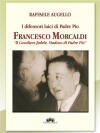 Francesco Morcaldi
Francesco Morcaldi
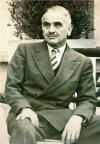
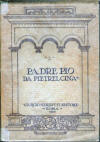 Emanuele Brunatto
Emanuele Brunatto
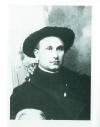 Don Giuseppe Orlando
Don Giuseppe Orlando
Morcaldi, Brunatto and Orlando went to Rome to try prevent the transfer.
Brunatto told Gemelli that he was an eye witness that Gemelli had not
examined Padre Pio. Gemelli replied that he could have him destroyed!
[57]
Morcaldi told Cardinal Donato Sbarretti that if they tried to remove
Padre Pio, they “will have to trample on our dead bodies.”
Don Giuseppe Orlando met Don Alessandro Lottini at the Holy Office. He
returned to Padre Pio and told him: “They are accusing you of all sorts
of things, including that you are disobedient to the orders of your
superiors who have imposed upon you the obedience to leave this place.”
Padre Pio fell on one knee, opened his arms, and declared: “Peppino, I
swear to you on this crucifix that I never received such an order. If my
superiors ordered me to jump out of the window, I would jump.”
[58]
Carmelo Camilleri
In the meantime, the townspeople were maintaining a round-the-clock
guard at the friary. Dr. Carmelo Camilleri was sent from Rome to explore
the possibility of moving Padre Pio. He concluded that Padre Pio could
be taken away only by force “with the certainty of an effusion of
blood.” This became evident few days later.[59]
[60]
Order of transfer
Padre Luigi D'Avellino
On July 30, 1923 Padre Luigi D’Avellino, by order of the superior
general Giuseppe Antonio da Persiceto went to Padre Pio notifying him
the he would be transferred to another convent.”[61]
Padre Pio said: “I am ready to do the will of my superiors. If at all
possible I’d like to go to Montefusco.”[62]
Donato Centra
On August 10, 1923 during vespers Padre Pio was about to bless the
faithful with the monstrance when a man, identified as Donato Centra, a
bricklayer, lunged forward, and brandishing a revolver, leveled it at
Padre Pio’s head. He shouted: “Either dead or alive, you are going to
stay with us in this town.” The bystanders wrestled him to the ground
before he could squeeze the trigger.[63]
[64]
[65]
Ancona
On August 4, 1923 Padre Cherubino da Castelnuovo of the Ancona convent,
notified padre Pietro da Monteroberto, superior of the nearby convent in
Cingoli, that Padre Pio would be transferred to that convent.[66]
Hearing that the removal of
Padre Pio had to be done in secret, Padre Cherubino suggested to hide
Padre Pio in a large barrel placed on a wagon. Padre Ignazio da Ielsi
reported the episode and commented that they didn’t know the people of
San Giovanni Rotondo.[67]
Suspension of transfer
On August 17, 1923 a telegram arrived from the Holy Office to the
convent, stating that the transfer order was suspended until further
notice.[68]
[69]
Meanwhile
On October 2, 1923 Mary Pyle met Padre Pio.
Padre Pietro da Ischitella
On February 23, 1924 Padre Pietro da Ischitella dropped dead of a heart
attack at the age of forty four.[70]
Padre Bernardo D'Alpicella
On April 14, 1924 the provincial Padre Luigi D’Avellino is removed and
substituted with Padre Bernardo D’Alpicella.[71]
Padre Celestino
Padre Celestino became later bishop Celestino Cattaneo.
On April 18, 1924 Padre Celestino da Desio was at the convent again,
sent by the superior general. He asked the superior of the convent
,Padre Ignazio, if it was true that there had been a fistfight among the
friars to appropriate the offers sent to Padre Pio. Padre Ignazio was
appalled at this absurd accusation and said that he could imagine who
was spreading a similar calumny.[72]
Ospedale San Francesco
Meanwhile, in January 1925 the St. Francis hospital was opened downtown
San Giovanni Rotndo.
Padre Bernardo
Padre Bernardo D'Alpicella
On April 22, 1925, at the request of the Holy Office, the provincial
superior Padre Bernardo
d’Alpicella ordered:
visitors are no longer permitted to talk to Padre Pio in the sacristy,
corridor, or guest room.
Padre Pio is prohibited to speak to any lay person after Mass, and his
hand has not to be kissed.
No layman can reside in the friary (Emanuele Brunatto went to
Pietrelcina).
The superior of the convent was Padre Ignazio da Ielsi, who wrote in his
diary: “Padre Pio never went again in any of the abovementioned places,
unless he was sent by me.”[73]
Hernia operation
Meanwhile Padre Pio had a hernia operation on October 5, 1925.
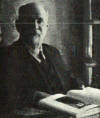
Dr. Giorgio Festa did the surgery
Miscio
In December 1925 canon Giovanni Miscio tried to blackmail Padre Pio’s
brother Michele. He was found guilty and received a suspended sentence
at the insistence of Padre Pio.[74]
“COMUNICATO” April 23, 1926
On April 23, 1926 the “Acta Apostolicae Sedis” issued a notice that the
booklet with preface by Giuseppe De Rossi (pseudonymous of Emanuele
Brunatto), by the title “Padre Pio da Pietralcina” was considered a
prohibited book. [75]
The booklet by Giuseppe De Rossi alias of Emanuele Brunatto
Reminder
In the same “COMUNICATO” there was a reminder to the faithful that “was
they duty to avoid visiting Padre Pio, or having with him even a simple
correspondence in writing.”
A stronger reminder
Canons
Canon Domenico Palladino
In March 1927 a committee that included Mons. Felice Bevilacqua,
Emanuale Brunatto, and Padre Alfredo Quattrino was sent to investigate
the cathedral’s chapter of canons in the diocese of Manfredonia. Some of
the canons were from the San Giovanni Rotondo’s clergy, including don
Giuseppe Prencipe, Miscio and Palladino. The investigators dredged a
wealth of sordid scandals.[76]
Mons.
Bruno
In May 1928 Mons. Bruno substituted on the committee Mons. Bevilacqua,
who had been dismissed. Mons. Bruno focused on the archdioceses of
Manfredonia and the Archbishop Gagliardi. After the report was presented
to the Holy Office Mons. Gagliardi retired to his native village of
Tricarico, Palladino was suspended “a divinis” and went to the Tremiti
islands, the archpriest Prencipe, the canon De Nittis and canon Miscio
had legal consequences.[77]
[78]
Dream
Mons. Pasquale Gagliardi
Mons. Sebastiano Cuccarollo
On May 5, 1929 Padre Pio reported a dream that Mons. Gagliardi would leave and Mons. Cuccarollo would be the new archbishop of Manfredonia.[80] In fact Mons. Gagliardi left. But Mons Cuccarollo was proposed the transfer, but he refused for a more lucrative assignment.
Mons. Alessandro Macchi was named Administrator of the
archdiocesis of Manfredonia in June 1929.[81]
Mons.
Macchi
Mons. Alessandro Macchi (center)
On December 2, 1929, sent by the Holy Office, Mons. Alessandro Macchi,
bishop of Como, named administrator of Manfredonia, went to
investigate Padre Pio. He reported: “Padre Pio might have been a saint,
but now he is a fool. He lacks the fundament of sanctity, which is
humility. He used cologne given to him by his bigot ladies.” He also
presented a project to “take Padre Pio to a convent in Switzerland.”[82]
“Letter to the Church”
Emanuele Brunatto had written a book called “Letter to the Church.” The
book contained a defense of Padre Pio and uncovered the private lives of
prominent churchman opposed to him.[83]
Don Luigi Orione tried repeatedly to convince Brunatto not to publish
the book.[84]
Barricades
On March 31, 1931, the news spread in town that shortly a new superior
would come to the convent from the province of Milan, and that this move
was the harbinger of Padre Pio’s imminent transfer. Within short order
the friary was surrounded day and night by citizen armed to the teeth,
just as it had been in 1923. Barricades were thrown up in the streets so
that no vehicular traffic could get to or from the friary.[85]
Padre Eugenio Tignola
On April 7, 1931, unaware of the turmoil, Padre Eugenio Tignola, a
Franciscan friar, went to the convent by bus, hoping to talk to Padre
Pio about a personal problem. On the bus somebody wrongly suspected that
he was coming to get Padre Pio. Within minutes a news spread: “They are
taking Padre Pio away!” At 10:00 PM an ugly mob demanded that “the
stranger” be handed over. Padre Pio told the crowd from the window in the choir: “You
have always been good. Listen to me. Return to your homes without
hurting anyone.” Major Morcaldi, who was in the crowd, went to speak
with Padre Raffaele, and was convinced that “the stranger” was an
harmless guest. At about 2:30 AM on April 8 the crowd finally started to
disperse. In the early hours of the morning after Padre Eugenio
was able to get on the first bus for Foggia, and was happy to reach
Napoli later in the day.
[86]
Major Francesco Morcaldi
The report of what had happened soon reached Rome, and action was
taken soon.[88
“Imprisonment”
On May 23, 1931 the Holy Office (prot.255-19) sent to the superior general of the Capuchin order Padre Melchiorre da Benisa, the following directive:
“This Supreme Congregation, in Plenary Assembly, emanates the following Decree:
“Padre Pio is stripped of all the faculties of the priestly ministry
except the faculty to celebrate the Holy Mass, which he may do in
private, within the walls of the friary, in the inner chapel, and not
publicly in church.”
The original directive is in Latin: “Patri Pio a Pietrelcina omnes
auferantes facultates ministeriales, excepta tantum facultate S. Missam
celebrandi, sed intra septa dumtaxat monasterii, in sacello interior,
privatim, non in ecclesia publica.”
The day after Padre Melchiorre wrote to the
Provincial Superior in Foggia that from then on the convent of San
Giovanni Rotondo depended directly from the superior general .
On May 25, 1931 the provincial superior notified
Padre Raffaele, the superior of the convent in San Giovanni Rotondo, of
the disposition.
On June 8, 1931 Padre Gregorio da Bruna, general
administrator of the Capuchin order, sent a letter to Padre Raffaele. In
the letter was enclosed the decree from the Holy Office. Padre Gregorio
ordered Padre Raffaele to execute the decree and inform him of the
outcome.
Padre Raffaele received the letter on June 9, 1931.
He was flabbergasted. He kept it locked for a day.
In the evening of June 10, after vespers, he waited
for Padre Pio to complete his prayers, sat with him alone, and notified
him of the decree. Padre Pio said only few words:
“The will of the authority is the
will of God.”
[89]
Then Padre Pio returned to the choir to pray until after midnight.
The following day was the feast of “Corpus Domini”.
From then on Padre Pio celebrated Mass in the little chapel of the
convent for more than two years.
This period of Padre Pio’s life has been called “imprisonment”.
He began his day with the rest of the community saying the Office in the
choir. He then prepared for Mass, and went to celebrate in the small
chapel of the friary in the company of one server.
Since no time limit was set, the Mass lasted up to four hours. He spent
the rest of the day in study and prayer.
One day Padre Agostino asked him how he passed his time. Padre Pio: “I
pray and study as much as I can, then annoy my brothers. I joke the way
I always joke with them, but my jokes are worse than before.”[90]
Spiritually he was tormented by the thought of “weather I am pleasing
the Lord in what I am doing.” In 1931 he told Padre Agostino: “Jesus is
silent.” In 1932 he told him “that often Jesus makes himself felt,
speaking to his soul, and granting him intellectual visions”. He also
experienced the presence of Mary and of his Guardian Angel.[91]
Padre Alberto testified: “From June 11, 1931 to July 15, 1933, Padre Pio
could say Mass only behind locked doors. I served his Mass many times
during those two years. It lasted about three hours. The memento was
interminable. At the Consecration he looked like Jesus Crucified. The
memento of the dead was also very long. At the Communion his face was
bright and radiant. After Mass he went to the choir for thanksgiving and
meditation until noon.”[92]
Padre Pio frequently said:
“The hand of the Church is sweet, even when
it strikes, because is the hand of the mother.”[93]
Seraphic College
On May 23, 1931,
by specific disposition from Rome,
the superior general of the Capuchin Order ordered the closure of the
Seraphic College of the convent. Padre Pio was the spiritual director of
the student, and suffered intensely for the closure. The College, for
middle school level students, had been functioning since November 1909.
The closure had to be implemented “by extinction”, not accepting new
students when the previous left. By September 1932 all the students had
left.[94]
On that date the seraphic college was transferred to the convent of Tora
(Caserta).[95]
Brunatto
In 1933 Emanuele Brunatto threatened again to publish his book “Letter
to the Church”, if Padre Pio was not released.[96]
[97]
Meanwhile Padre Raffaele reported: “Padre Pio was sick in bed with a
118F fever, during the Holy Week of 1933. The only thing he did was
suffering and crying.”[98]
Pasetto and Bevilacqua
Pope Pius XI
In 1933 Cardinal Eugenio Pacelli convinced Pope Pius XI to send a
personal representative to observe Padre Pio. On March 14, 1933 Mons.
Luca Pasetto
a capuchin bishop of Gera,
and Mons Felice Bevilacqua went to San Giovanni Rotondo, sent by the
Pope.
Mons. Bevilacqua had been Apostolic Visitor in 1927.
They spent time with Padre Pio. They found no wild-eye fanatic, no
crazed neurotic, no embittered rebel, but a pleasant, humble, docile,
humorous man; a man of prayer and entirely godly. Bevilacqua warned
Padre Pio about the terrible damage to the Church should the revelations
of Brunatto become public. Padre Pio said: “The Church has a formidable
weapon to neutralize the scandal, refuting the episodes alleged in the
book.” Mons. Bevilacqua, his eyes brimming with tears, shook his head
and said in a chocked voice: “Unfortunately, those allegations are
true.” The book was never published.[99]
Mons. Pasetto’s favorable report to the Pope was instrumental in
modifying his opinion about Padre Pio. In fact, soon the restriction
where lifted.[100]
Indult
On July 14, 1933 a “Indult” came from the Holy Office, signed by
Cardinal Sbarretti, directing that Padre Pio, in consideration that 1933
was a Holy Year celebrating the Redemption, be allowed to celebrate Mass
in public, and to hear the confessions of the other friars.[101]
The evening of July 15 Padre Pio was notified the good news. The next
day the church was packed for Padre Pio’s first Mass in public in more
than two years.[102]
July 16, 1933
Restrictions
There were still many restrictions remaining in place: Padre was not
allowed to hear the confessions of laypersons, the sacristy was off
limits to all laity, he could not speak to women or let them kiss his
hand, the talks with men in the hallway had to be few and brief, the
Mass was not to last more than a half hour.
[103]
[104]
On March 25, 1934 Padre Pio was allowed by the Holy Office the
confession of men, and on May 12, 1934 he was permitted to hear the
confessions and women.
[105]
Thus his ministry was once again
in full swing.[106]
August 10, 1935 was the 25th anniversary of priesthood of
Padre Pio: sober celebration among many faithful.[107]
Mass in public on August 20, 1935
On August 29, 1936 the Provincial Padre Bernardo D’Alpicella reiterates
that is prohibited for lay people to enter in Padre Pio’s cell; also was
ordered to keep locked the cloths used by Padre Pio on the wounds, and
whomever had they had to return them. Otherwise if priests would be
suspended “a divinis”, and if lay they would be interdicted from
receiving Holy Communion.[108]
Accusations
In 1937 the accusations of not implementing the wows of poverty,
chastity and obedience intensified against Padre Pio, and many anonymous
letters were sent to the Holy Office. He was accused of managing by
himself the conspicuous donations of the faithful, of seeing women in
the convent at night, of not obeying to say Mass in 30 minutes. All the
accusations were patiently evaluated, investigated, and controlled by
the superiors in the Capuchin order. Nothing was found to be true.[109]
Padre Donato da Welle
Padre Donato da Welle
On August 7, 1938, the new superior general of Capuchins Padre Donato da
Welle, Belgium, visited Padre Pio. He wrote: “I examined the stigmata
and observed Padre Pio, and
asked any kind of questions. I can and must affirm that I consider Padre
Pio a great saint!”[110]
Pius XII
On March 2, 1939 Cardinal Eugenio Pacelli was elected Pope Pius XII. In
one of his first moves he ordered the Roman Congregations to “leave
Padre Pio alone” and called Padre Pio “The salvation of Italy.”[111]
[112]
Bibliography
Agostino, d. S. (2012). Diario. San
Giovanni Rotondo: Edizioni Padre Pio.
Ago12
Alberto, D'Apolito (2007). Padre Pio
of Pietrelcina. Memories. Experiences. Testimonials. San Giovanni
Rotondo: Edizioni Padre Pio.
Alb07
Capuano, P. (2012). Con p. Pio: come
in una fiaba. Foggia: Grafiche Grilli.
Cap12
Castelli, F. (2011). Padre Pio under
investigation. The secret Vatican files. San Francisco: Ignatius
Press.Cas11
Chiron, Y. (1999). Padre Pio. Una
strada di misericordia. Milano: Figlie di San Paolo.
Chi99
Giannuzzo, E. (2012). San Pio da
Pietrelcina. Il travagliato persorso della sua vita terrena. Book
sprint edizioni.
Gia12
Iasenzaniro, M. (2007). Charismatic
piest. Testimonies. San Giovanni Rotondo: Edizioni Padre Pio.
Ias07
Malatesta, E. (1999). La vera storia
di Padre Pio. Casale Monferrato: PIEMME.
Mal99
Peroni, L. (2002). Padre Pio da
Pietrelcina. Borla.
Per02
Riese, padre Ferdinando da (2010).
Padre Pio da Pietrelcina crocifisso senza croce. San Giovanni
Roronto: Edizioni Padre Pio.
Fer10
[1] Mal99, 326
[2] Gia12, 166
[3] Ruf91, 168
[5] Per02, 272
[6] Mal99, 263
[7] Pre00, 123
[8] Ruf91, 169, 183, 190
[9] Pre00, 123-4
[10] Per02, 282
[11] Chi99, 161-2
[12] Per02, 274
[13] Pre00, 124
[14] Per02, 282-3
[15] Fer10, 145-6
[16] Gia12, 143
[17] Cas11, 86
[18] Fer10, 146
[19] Mal99, 123
[20] Mal99, 134
[21] Gia12, 140
[22] Cas11, 5
[23] Cas11,64
[24] Cas11, 5
[25] Gia12, 204-5
[26] Cas11, 6
[27] Gia12, 206
[28] Cas11, 232
[29] Cas11, 27
[30] Cas11, 94
[31] Cas11, 132
[32] Cas11, 124
[33] Cas11, 125-6
[34] Cas11, 126
[35] Cas11, 202
[36] Cas11,107
[37] Cas11, 81-133
[38] Cas11, 201
[39] Cas11, 231
[40] Cas11, 272
[41] Cas11, 292
[42] Per02, 298
[43] Per02, 302
[44] Gia12,232
[45] Gia12, 234
[46] Per02, 302
[47] Per02, 301
[48] Per02, 301
[49] Ruf91, 198
[50] Cas11, 292
[51] Ias07, 598
[52] Per02, 303
[53] Ruf91, 193
[54] Ias07, 598
[55] Per02, 307-8
[56] Ruf91, 189-98
[57] Per02, 339-1
[58] Per02, 319-20
[59] Ruf91, 189-98
[60] Per02, 310
[61] Per02, 311
[62] Per02, 312
[63] Per02, 313
[64] Ruf91, 197
[65] Cap12, 19
[66] Ias07, 598
[67] Per02, 322
[68] Ruf91, 198
[69] Ias07, 599
[70] Per02, 320-1
[71] Ias07, 599
[72] Per02, 321
[73] Ias07, 600
[74] Ruf91, 220-1
[75] Ruf91, 223
[76] Ruf91, 223-4
[77] Per02, 344
[78] Gia12, 277-8
[79] Per02, 352-5
[80] Ago12, 86
[81] Gia12, 282
[82] Ga12, 385
[83] Ruf91, 229
[84] Gia12, 285-6
[85] Ruf91, 229
[86] Per02, 366-7
[87] Ruf91, 110-30
[88] Per02, 365-7
[89] Per02, 368-9
[90] Ruf91, 231
[91] Ruf91, 232
[92] Alb07, 97-9
[93] Per12, 374
[94] Ago12, 101 note
[95] Cap12, 20
[96] Ruf91, 235
[97] Per12, 375-8
[98] Chi99, 220
[99] Ruf91, 234-5
[100] Ago12, 104-5 note
[101] Gia12, 301
[102] Per02, 378-9
[103] Per02, 399-400
[104] Gia12, 300
[105] Ago12, 106
[106] Ruf91, 236
[107] Cap12, 21
[108] Cap12, 21
[109] Gia12, 307-9
[110] Ruf91, 238
[111] Gia12, 311
[112] Alle99, 502


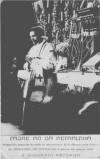
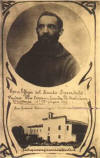

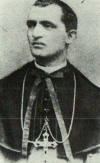


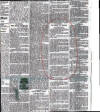


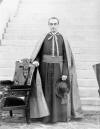
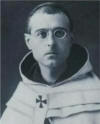

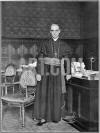
_small.jpg)

